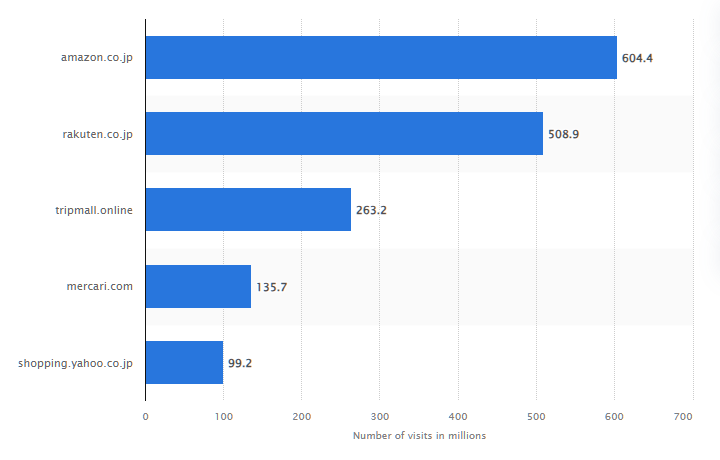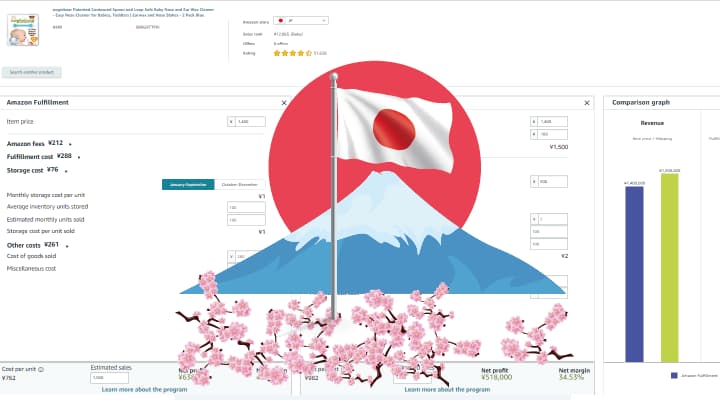
Amazon Japan’s Fulfillment by Amazon (FBA) program has grown in popularity among domestic and international sellers, as it provides an efficient and convenient method for businesses to manage inventory and reach local customers. By utilizing FBA, sellers can store their products in Amazon’s warehouses within Japan, allowing the e-commerce giant to handle storage, packaging, shipping, and customer service, ultimately streamlining the sales process.
Understanding the fees and requirements associated with selling on Amazon Japan is crucial for businesses looking to enter this lucrative market. The professional plan costs ¥4,900 per month, with referral fees calculated by multiplying the total item price (including shipping and handling) as a percentage, which varies depending on the product category.
Selling on Amazon Japan via FBA also necessitates compliance with local taxes and regulations and Amazon’s specific category requirements. Familiarizing oneself with recommended products by category—and making informed shipping choices, whether self-fulfilling or using FBA—will help ensure a successful selling experience in the Japanese market.
Overview of Amazon Japan FBA
What is Amazon FBA?
Amazon FBA (Fulfillment by Amazon) is a service provided by Amazon that allows sellers to store their products in Amazon’s fulfillment centers, freeing them from the hassle of dealing with storage, packaging, and shipping. Amazon takes care of all these logistics tasks, which enables sellers to focus on their core business, such as product development, marketing, and customer service. By using Amazon FBA, sellers can easily sell their products on Amazon’s Japan store, reaching tens of millions of potential customers.
Benefits of Using Amazon Japan FBA
- Expanded customer base: Amazon Japan FBA grants sellers access to a vast market of potential customers familiar with the Amazon platform. Tapping into this market can hugely widen a seller’s reach.
- Local language management: As Japanese is the primary language used in the Japanese marketplace, some sellers might struggle with language barriers. Amazon Japan FBA provides ample support for language management, aiding sellers in overcoming this issue.
- Enhanced shipping services: When sellers utilize Amazon FBA, their products become eligible for Amazon Prime, offering Amazon Japan’s customers faster shipping options such as Same-Day Delivery or One-Day Shipping, which can lead to increased sales.
- Effortless returns management: Amazon handles the intricate process of managing returns for FBA sellers, simplifying the entire procedure and removing the requirement to set up a separate system to handle returns.
- Customer service support: As part of the FBA service, Amazon provides customer service in Japanese, ensuring customers get the support they need, resulting in better customer satisfaction rates.
By employing Amazon Japan FBA, sellers can not only simplify and streamline their processes, but they also have the potential to increase their customer base and boost sales significantly.
Setting Up an Amazon Japan FBA Account
Registration Process
To set up an Amazon Japan FBA account, create your Amazon seller account using your existing customer account or a new business email. Next, log in to Seller Central and pay the required monthly fee (excluding tax) plus selling fees. Once your account is registered, you can focus on setting up your Japan FBA account.
Account Requirements
When selling on Amazon Japan, it is crucial to comply with local regulations and taxes. Ensure to understand the category requirements and review the list of recommended products by category. Also, be prepared to handle tax obligations, such as registering for Value Added Tax (VAT) if you store stock in Japan.
Shipping to Amazon FBA in Japan
After setting up your FBA account, follow these steps to prepare and ship your products to Amazon FBA in Japan:
- Create international product listings: Add your products to the Amazon catalog and specify FBA inventory.
- Prepare products: Package your products securely to avoid any damage during shipping. Always follow Amazon’s packaging and labeling guidelines.
- Ship to FBA fulfillment center: Create a shipment plan within Seller Central and send your products to Japan’s designated Amazon FBA fulfillment center.
By following these steps and adhering to Amazon’s guidelines, you can smoothly establish your Amazon Japan FBA account and start selling to customers in Japan.
Understanding Japan’s Ecommerce Market

Online Shopping Trends in Japan
Japan is the fourth largest ecommerce market in the world, attracting a wealthy population that frequently shops online. This trend has steadily increased as Japanese consumers adopt online shopping platforms. In 2015, the combined user base of Amazon.co.jp sites reached nearly 604.4 million visitors.

Necessities, fashion, and electronics are among the top-selling items in the Japanese ecommerce market. Customers appreciate fast delivery and a hassle-free shopping experience from platforms like Amazon.
Amazon Japan’s Market Share
Amazon Japan holds a significant market share in the Japanese ecommerce landscape. Their vast product offerings, fast shipping, and excellent customer service have led to millions of daily users, contributing to the platform’s consistent growth.
Logistics for FBA Japan
With Amazon Japan FBA, sellers can become part of Japan’s thriving ecommerce market by leveraging Amazon’s extensive logistics infrastructure. Sellers can send their products to Amazon’s FBA warehouse in Japan, let Amazon categorize and store the items, and sit back while Amazon handles customer service and shipping.
Customer Behavior
Japanese customers value superior product quality and are willing to pay for well-crafted items. Additionally, they appreciate exceptional customer service and expect seamless after-sales support. This behavior emphasizes the importance of providing efficient shopping experiences.
When selling on Amazon Japan, understanding Japanese customers’ needs becomes crucial for success. Conducting product research and gathering information on consumer preferences can help tailor your offerings to suit Japanese shoppers’ requirements. Adapting your products and customer service to the unique expectations of the Japanese market can contribute to a more profitable and thriving business.
Regulatory Compliance and Legal Challenges
Japanese Laws and Regulations
Amazon Japan FBA (Fulfillment by Amazon) must adhere to Japanese laws and regulations while operating in the country. The eCommerce giant faces scrutiny from regulators in Japan, where it has a significant market share. Amazon held a 23% share in Japan’s internet retail market, surpassing its Japanese rival Rakuten’s 18.5% share in 2016.
The OECD report details Amazon Japan’s commitment to comply with Japanese competition laws. These laws aim to maintain fairness in business activities and protect consumers from harm caused by anti-competitive practices. Additionally, the regulations require that Amazon transparently provide data regarding its third-party sellers and information about its supply chain and overall impact on the market landscape.
Product Compliance in Amazon Japan FBA
In addition to adhering to Japanese laws, Amazon Japan FBA must ensure its products comply with safety and quality standards. Non-compliance with these standards, such as intellectual property rights infringement and false advertising, could lead to legal issues and subsequent financial consequences for the company. For example, a California appeals court ruling held Amazon liable for defective products sold through its website, even if sold by third-party sellers.
When using the FBA service, sellers must also comply with Japanese product requirements. Proper labeling, packaging, and product safety are crucial to meet these requirements. Furthermore, sellers must adhere to data protection laws and any applicable sales tax regulations in Japan. Understanding and abiding by these regulations helps both Amazon Japan and sellers using its platform avoid legal issues and maintain a positive relationship with regulators.
Operational Considerations in Japan
Inventory Management
When selling on Amazon Japan FBA, managing inventory is crucial. From forecasting demand to ensuring products are stocked up, it is essential to have a clear understanding of your inventory levels. Keep track of your sales history to predict future demand and identify seasonal trends. Optimize the order frequency to minimize stockouts and overstocking. While sending products to Amazon fulfillment centers in Japan, comply with their packaging and labeling requirements. Remember to monitor inventory performance and adjust your replenishment strategies accordingly.
Product Returns
Handling product returns is an inevitable aspect of the Amazon Japan FBA business. Awareness of the local laws and regulations related to consumer rights is essential. As a seller, it’s important to set clear and fair return policies that comply with Amazon’s guidelines.
Here are some key aspects to consider:
- Ensure products are accurately depicted, well-packaged, and in good condition when shipped.
- Track customer feedback to identify recurring issues and improve product quality.
- Implement a proactive approach to minimize returns by providing detailed product descriptions, high-quality images, and customer support where needed.
- Handle returns efficiently, offering prompt solutions and refunds when necessary.
Customer Service
Providing excellent customer service is crucial for success on Amazon Japan FBA. Sellers must be able to communicate with Japanese customers, addressing their queries and concerns, possibly via phone or email. Maintaining a professional and respectful tone when dealing with customers is essential. Some sellers hire native Japanese-speaking customer service representatives to ensure seamless communication.
In addition to language proficiency, consider the following aspects of customer service:
- Respond to customer inquiries promptly and accurately.
- Use the available Amazon resources and tools to manage customer contacts effectively.
- Keep a close eye on customer reviews and ratings, as these play a significant role in your product’s visibility and sales.
- Continuously strive to improve customer satisfaction by analyzing their feedback and making necessary adjustments to your processes or products.
By focusing on these operational considerations, Amazon sellers in Japan can develop a strong foundation for their FBA business and navigate the unique challenges and opportunities in the Japanese market.
Strategies for Success in Amazon Japan FBA Market

Product Selection
The Japanese market offers unique opportunities and challenges for Amazon FBA sellers. Identifying the right products is essential in gaining and maintaining market share. Analyze market trends and categories with high demand and low competition, as mentioned in the Amazon product research guide.
Focus on the preferences and needs of Japanese customers. Research their purchasing behavior, cultural aspects, and popular items to plan a well-targeted product range.
Localization
Localization plays a crucial role in succeeding in a foreign market like Japan. Ideally, offer bilingual packaging, instructions, and customer support to appeal to Japanese and English-speaking consumers. Proper localization also covers adapting products to Japanese standards, metric systems, and legal requirements. Familiarize yourself with Amazon Japan’s rules and fulfillment requirements to avoid any hiccups in your expansion.
Additionally, pay close attention to:
- Product listing language: Translate product titles, descriptions, and keywords accurately
- Payment methods: Consider using popular local payment options like JCB, Pay-easy, and NTT Docomo
- Customer service: Provide native Japanese-speaking support, if possible
Brand Representation
Standing out from the crowd is vital in the competitive Amazon Japan landscape. Elevate your brand by focusing on presentation and reputation. Create a visually appealing brand presence by investing in high-quality images, product videos, and persuasive marketing copy. As sales velocity plays an essential role in search ranking, attract customers by offering competitive prices and promotions.
Collect positive reviews by providing excellent customer service, ensuring product quality, and fast shipping times. Engage customers using social media and other marketing channels to establish a strong brand identity. Remember, building trust and showcasing your brand’s reliability will help you win the hearts of Japanese customers.
Conclusion of Amazon Japan FBA
Amazon Japan FBA offers a lucrative opportunity for sellers to target millions of consumers in Asia. The platform’s huge audience is continuously growing, making it an attractive option for Amazon global sellers. Furthermore, Amazon assists in navigating the complex process of expanding into the Japanese market, such as the translation of listings and customer support.
Understanding the Japanese market and consumer preferences is crucial for success. Adapting product offerings to align with local customer demands and trends will increase the likelihood of generating sales in this competitive landscape. Additionally, compliance with local regulations and tax obligations is essential to avoid legal issues.
An efficient and reliable fulfillment strategy, such as using Amazon FBA Japan, enables sellers to meet customer expectations for fast shipping and high-quality service. This strategy can help establish a reputable presence on the platform, leading to positive reviews and repeat business.
In conclusion, sellers seeking to expand into Amazon Japan FBA should be prepared to invest time and effort into understanding local preferences, meeting legal and tax obligations, and developing a well-executed logistics strategy. By doing so, they can position themselves for success in this promising market.
Frequently Asked Questions
How does FBA operate in Japan?
Fulfillment by Amazon (FBA) works in Japan by allowing sellers to store their products in Amazon’s distribution centers, known as fulfillment centers. Amazon handles the sellers’ storage, order processing, shipping, returns, and customer service. Sellers can track their FBA inventory via their Seller Central account. FBA ensures a smoother and more efficient selling experience for sellers in the Japanese market.
What are the fees associated with using FBA in Japan?
The fees associated with FBA in Japan typically include a monthly subscription fee, storage fees, and applicable selling fees. The monthly subscription fee is ¥4,900 (excluding tax), while storage fees are determined based on the product’s size and duration of storage. Selling fees can vary depending on the product’s category and price. It’s essential to consider these fees when calculating potential profit margins. You can find more details about Amazon Japan FBA fees here.
Are there any product restrictions for selling on Amazon Japan?
Yes, there are product restrictions when selling on Amazon Japan. Before listing products, sellers must comply with local laws and regulations. Sellers should also know any necessary category requirements and review recommended products by category on Amazon.co.jp. Failure to comply with these regulations can result in penalties or account suspension. Reviewing the restricted product list before selling on Amazon Japan is important.
How does Amazon Japan Global affect international sellers?
Amazon Japan Global offers international sellers the opportunity to expand their reach by selling on the Amazon.co.jp platform. International sellers must comply with Japan’s local laws and regulations to successfully sell on Amazon Japan, especially taxes and product requirements. Amazon Japan Global enables international sellers to access a vast customer base, provided they follow the necessary rules and guidelines.
How can I calculate FBA fees for selling products in Japan?

To calculate FBA fees for selling products in Japan, sellers can use the Amazon Japan FBA Revenue Calculator. This tool allows sellers to input various product details, such as dimensions, weight, product category, and selling price. The calculator then generates estimated FBA, storage, and selling fees, which can help sellers understand their potential profit margin and decide product pricing.
Denes, with 20 years experience in logistics, holds a Logistics Manager degree from Budapest’s Logistics Association and has penned a thesis on mobile devices. Venturing into e-commerce, Denes specializes in Fulfilled By Amazon and passionately educates others about Amazon selling techniques.